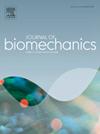患有脑瘫的流动儿童与正常发育的儿童有着相似的腿部肌肉力臂
IF 2.4
3区 医学
Q3 BIOPHYSICS
引用次数: 0
摘要
许多患有脑瘫(CP)的儿童有肌肉挛缩和骨骼畸形。据推测,这些肌肉骨骼异常可能会增加或减少肌肉力臂并导致运动功能障碍。在这项研究中,我们首先研究了骨骼生长(胫骨长度)与200名5 - 15岁典型发育儿童的磁共振图像中跟腱和胫骨前矩臂的三维测量之间的关系。力臂随胫骨长度线性增加。为了确定脑瘫是否影响矩臂,我们还测量了79名CP患儿的跟腱和胫骨前矩臂(94%的大运动功能分类系统为I级或II级)。在调整胫骨长度、年龄和性别后,脑瘫儿童跟腱矩臂平均略大于正常发育儿童(平均差异1.4 mm, 95%可信区间(CI) 0.4 ~ 2.4;p & lt;0.01),胫骨前矩臂略小(平均差- 0.9 mm, 95% CI - 1.6 ~ - 0.2, p <;0.05)。我们得出结论,在5至15岁的儿童发育期间,力臂与胫骨长度呈线性关系。患有脑瘫的流动儿童的动臂与正常发育儿童的动臂平均略有不同,但这些差异太小,不会引起严重的踝关节功能障碍。本文章由计算机程序翻译,如有差异,请以英文原文为准。
Ambulant children with cerebral palsy have similar leg muscle moment arms to typically developing children
Many children with cerebral palsy (CP) have muscle contractures and bony deformities. It has been hypothesised that these musculoskeletal abnormalities could increase or decrease muscle moment arms and cause movement dysfunction. In this study, we first investigated the relationship between skeletal growth (tibia length) and three-dimensional measurements of Achilles tendon and tibialis anterior moment arms from magnetic resonance images of 200 typically developing children aged 5 to 15 years. Moment arms increased linearly with tibia length. To determine whether cerebral palsy affects moment arms, we also measured Achilles tendon and tibialis anterior moment arms from a predominantly ambulant cohort of 79 children with CP (94% Gross Motor Function Classification System Level I or II). After adjusting for tibia length, age and sex, the Achilles tendon moment arms of children with cerebral palsy were, on average, slightly greater than those of typically developing children (mean difference 1.4 mm, 95% confidence interval (CI) 0.4 to 2.4; p < 0.01) and tibialis anterior moment arms were slightly smaller (mean difference −0.9 mm, 95% CI −1.6 to −0.2, p < 0.05). We conclude that moment arms scale linearly with tibia length during childhood development from 5 to 15 years. Ambulant children with cerebral palsy have moment arms that differ slightly, on average, from the moment arms of typically developing children, but those differences are too small to cause significant ankle joint dysfunction.
求助全文
通过发布文献求助,成功后即可免费获取论文全文。
去求助
来源期刊

Journal of biomechanics
生物-工程:生物医学
CiteScore
5.10
自引率
4.20%
发文量
345
审稿时长
1 months
期刊介绍:
The Journal of Biomechanics publishes reports of original and substantial findings using the principles of mechanics to explore biological problems. Analytical, as well as experimental papers may be submitted, and the journal accepts original articles, surveys and perspective articles (usually by Editorial invitation only), book reviews and letters to the Editor. The criteria for acceptance of manuscripts include excellence, novelty, significance, clarity, conciseness and interest to the readership.
Papers published in the journal may cover a wide range of topics in biomechanics, including, but not limited to:
-Fundamental Topics - Biomechanics of the musculoskeletal, cardiovascular, and respiratory systems, mechanics of hard and soft tissues, biofluid mechanics, mechanics of prostheses and implant-tissue interfaces, mechanics of cells.
-Cardiovascular and Respiratory Biomechanics - Mechanics of blood-flow, air-flow, mechanics of the soft tissues, flow-tissue or flow-prosthesis interactions.
-Cell Biomechanics - Biomechanic analyses of cells, membranes and sub-cellular structures; the relationship of the mechanical environment to cell and tissue response.
-Dental Biomechanics - Design and analysis of dental tissues and prostheses, mechanics of chewing.
-Functional Tissue Engineering - The role of biomechanical factors in engineered tissue replacements and regenerative medicine.
-Injury Biomechanics - Mechanics of impact and trauma, dynamics of man-machine interaction.
-Molecular Biomechanics - Mechanical analyses of biomolecules.
-Orthopedic Biomechanics - Mechanics of fracture and fracture fixation, mechanics of implants and implant fixation, mechanics of bones and joints, wear of natural and artificial joints.
-Rehabilitation Biomechanics - Analyses of gait, mechanics of prosthetics and orthotics.
-Sports Biomechanics - Mechanical analyses of sports performance.
 求助内容:
求助内容: 应助结果提醒方式:
应助结果提醒方式:


